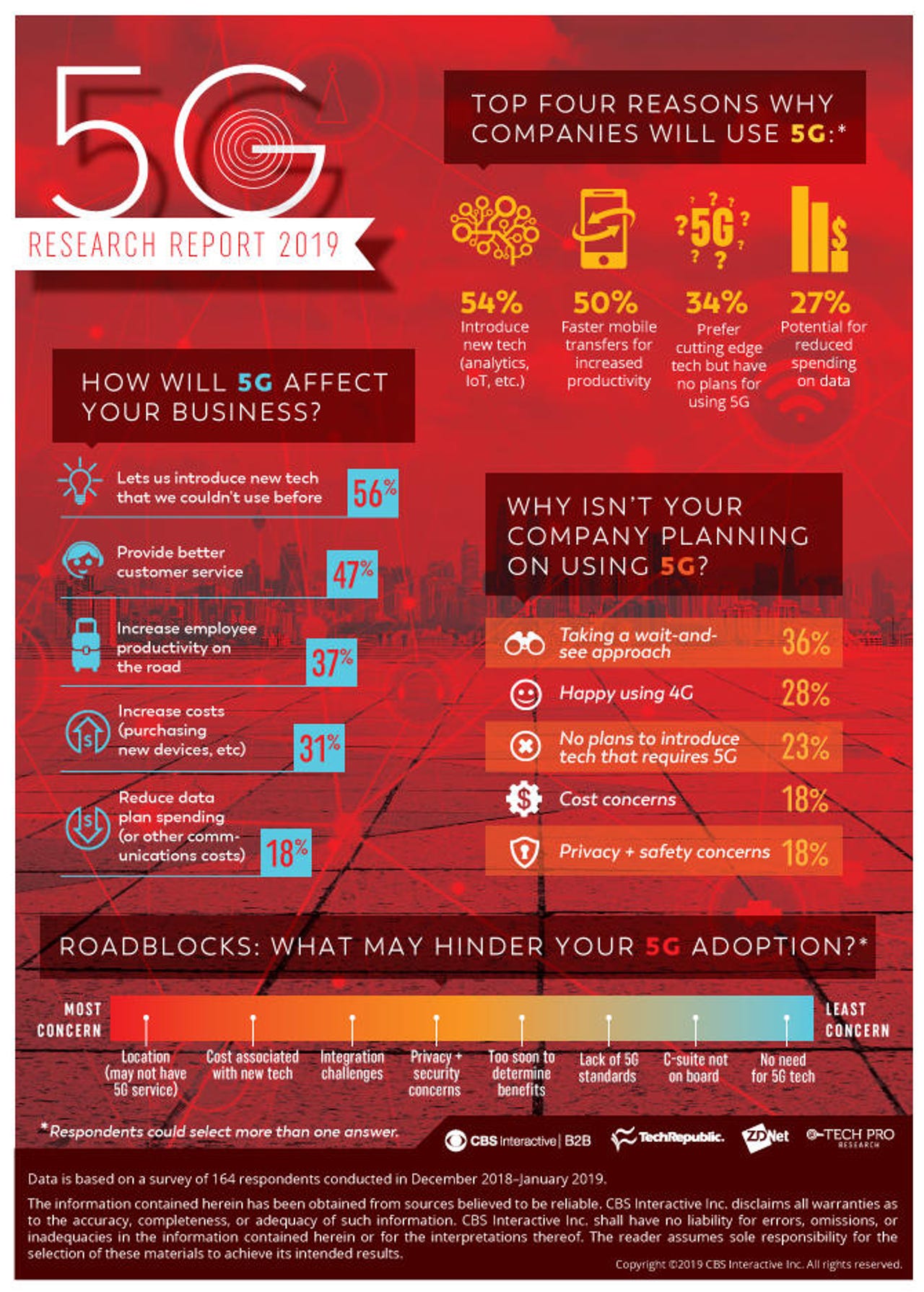Cloud computing trends, where developers want to live, AI skills, and 5G: Research round-up


Professionals eager and ready to deploy 5G
MWC 2019 in February brought the attention back to mobility - and a lot of that focus centred on 5G networks. Tech Pro Research shows 85 percent of respondents either already use 5G technology or plan to adopt it in the future. The results demonstrate the enterprise's enthusiasm for this new technology.
For more see: Professionals eager and ready to deploy 5G
5G initial use cases are going to be all about business
The 5G race is well underway and rest assured you'll see a lot of hype, a few new devices with better bandwidth and promises that likely won't be delivered until 2020 at the earliest. But don't get distracted: 5G will be a business event first. Here's a look at the enterprise use cases for 5G via Gartner. Simply put, 5G is going to enable a lot more than binge watching on your smartphone.
For more see: 5G initial use cases are going to be all about business
Tech and business decision makers have doubts amid 5G hype
But it's not all good news. An Accenture survey finds that business and technology decision makers believe in 5G to a degree, but aren't sold on the return on investment or use cases yet. More than half of executives say there is little that 5G will do for their businesses that they cannot already do with 4G networks.
For more see: Tech and business decision makers have doubts amid 5G hype
Enterprises are spending more on cloud computing
The RightScale 2019 State of the Cloud Report from Flexera highlights how enterprises are spending more on cloud computing, but are getting concerned about optimising their spending. Companies are going multi-cloud; half of them spend more than $1 million on public cloud.
For more see: Microsoft Azure grows workloads, adoption as it closes AWS gap, RightScale survey says
Azure adoption is on the rise
Microsoft Azure continues to grow workloads, according to the RightScale report. Azure adoption grew from 45 to 52 percent to narrow the gap with AWS. Azure adoption has now reached 85 percent of AWS adoption, up from 70 percent last year.
For more see: Microsoft Azure grows workloads, adoption as it closes AWS gap, RightScale survey says
Skills gap, corporate culture holding back AI adoption
Enterprises are facing a machine learning and artificial intelligence skill shortage even as they plow ahead with implementations. According to O'Reilly's 2019 artificial intelligence survey, 18 percent of respondents say that lack of skilled people is slowing adoption. As much as 60 percent of respondents are planning to spend at least 5 percent of their IT budgets on artificial intelligence.
For more see: Skills gap, corporate culture holding back AI adoption
AI is helping businesses deal with some key tasks
According to O'Reilly's 2019 artificial intelligence survey, a third of executives say their business is using AI for customer service or IT, and half are using AI for research and development projects.
For more see: Skills gap, corporate culture holding back AI adoption
Danger signs for UK's early-stage tech startup investments?
Brexit threatens to sever Europe's strongest technology hub from the interconnected European ecosystem of technical talent, investment and expertise, warns Tech.eu. Overall, total funding in European early-stage tech startups jumped by 36% from 2016 to 2017 (from €14.3 billion to €19 billion).
For more see: Danger signs for UK's early-stage tech startup investments?
Four in ten tech companies consider move abroad
In fact, Brexit worries are already leading companies to consider shifting some of their operations. A survey by the Institute of Directors shows 39 percent of companies working in information and communications have already set up operations elsewhere, are planning to do so, or are actively considering such a move.
For more see: Four in ten tech companies consider move abroad
London is still top for software developers, but European rivals are catching up fast
For now, London remains the top destination in Europe for international tech workers, and is now home to 357,900 software developers; but rival tech hubs are seeing rapid expansion. The number of developers in Paris increased by almost 50 percent through 2018, from 181,000 to 286,000.
For more see: London is still top for software developers, but European rivals are catching up fast
Huawei continues dominance as China's smartphone sales slow in Q4
Smartphone shipments in China dropped to 103 million units during the fourth quarter of 2018, down 9.7 percent year on year for the corresponding period, reports tech analyst IDC. Huawei continues its dominance in its domestic market, with IDC reporting that it sold 5.7 million more smartphones in Q4 2018 year over year.
For more see: Huawei continues dominance as China's smartphone sales slow in Q4: IDC
Intel’s neuro guru slams deep learning: ‘it’s not actually learning’
Finally, Mike Davies, head of Intel's neuromorphic computing unit, gave a talk about "Loihi", his team's computer model of a neural network that uses so-called spiking neurons that activate only when they receive an input sample. Intel says Loihi bests conventional neural network performance on conventional processors.
For more see: Intel's neuro guru slams deep learning: 'it's not actually learning'